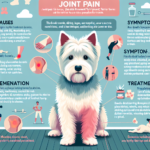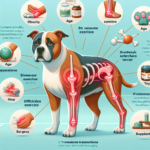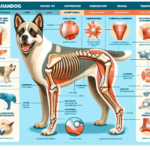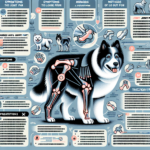Dandie Dinmont Terrier Joint Pain: Causes, Symptoms, Prevention, and Treatment

Introduction
The Dandie Dinmont Terrier is a small, distinctive breed known for its unique appearance and charming personality. Originating from the border regions of Scotland and England, this breed was initially developed for hunting small game such as otters and badgers. With its long body, short legs, and distinctive “topknot” of hair on its head, the Dandie Dinmont Terrier is easily recognizable. Despite its small size, this breed is known for its courage, intelligence, and affectionate nature.
Like many purebred dogs, the Dandie Dinmont Terrier is prone to certain health issues. Among these, joint pain is a significant concern that can affect the quality of life for these dogs. Joint pain can arise from various conditions, including hip dysplasia, arthritis, and other degenerative joint diseases. Understanding the causes, symptoms, prevention, and treatment of joint pain in Dandie Dinmont Terriers is crucial for ensuring their long-term health and well-being.
Joint health is particularly important for Dandie Dinmont Terriers due to their unique body structure and active nature. Maintaining healthy joints can help prevent pain and mobility issues, allowing these dogs to lead active and fulfilling lives.
Breed-Specific Joint Pain Risks
Genetic Predisposition
Dandie Dinmont Terriers have a genetic predisposition to several joint-related issues. Hip dysplasia, a condition where the hip joint does not fit properly into the hip socket, is one of the most common genetic issues affecting this breed. This condition can lead to arthritis and significant pain over time. Elbow dysplasia, although less common, can also occur in Dandie Dinmont Terriers, leading to similar issues in the front limbs.
Age-Related Risks
As Dandie Dinmont Terriers age, they become more susceptible to joint pain and degenerative joint diseases such as osteoarthritis. Typically, signs of joint pain may start to appear in middle age, around 5 to 7 years old, but can vary depending on the individual dog. It’s essential for owners to monitor their dogs for any signs of discomfort or mobility issues as they age.
Activity Level and Joint Stress
Dandie Dinmont Terriers are active and energetic dogs that enjoy regular exercise and play. However, their activity level can contribute to joint stress, especially if they engage in high-impact activities such as jumping or running on hard surfaces. While exercise is crucial for maintaining overall health, it’s important to balance activity levels to prevent excessive joint strain.
Common Symptoms of Joint Pain in Dandie Dinmont Terriers
General Symptoms
- Limping or favoring one leg
- Stiffness, especially after rest or sleep
- Reluctance to move, jump, or climb stairs
- Decreased activity or playfulness
- Visible discomfort or pain when touched
- Swelling around the joints
Breed-Specific Symptoms
In Dandie Dinmont Terriers, joint pain may manifest more noticeably in the hind legs due to their predisposition to hip dysplasia. Owners may observe a “bunny hopping” gait or difficulty rising from a lying position. Additionally, due to their long bodies and short legs, any changes in posture or movement can be more apparent.
When to Consult a Vet
If you notice any of the above symptoms in your Dandie Dinmont Terrier, it’s essential to consult a veterinarian promptly. Early diagnosis and intervention can help manage joint pain more effectively and improve your dog’s quality of life. Regular veterinary check-ups are also crucial for monitoring joint health and catching any issues early.
Preventive Measures for Joint Health
Exercise Recommendations
Regular, moderate exercise is vital for maintaining joint health in Dandie Dinmont Terriers. Activities such as walking, swimming, and gentle play can help keep joints flexible and muscles strong without causing excessive strain. Avoid high-impact activities like jumping or running on hard surfaces, which can exacerbate joint issues.
Dietary Suggestions
A balanced diet rich in essential nutrients can support joint health. Consider incorporating foods or supplements that contain glucosamine, chondroitin, and omega-3 fatty acids, which are known to promote joint health and reduce inflammation. Consult your veterinarian for specific dietary recommendations tailored to your dog’s needs.
Weight Management
Maintaining a healthy weight is crucial for reducing joint stress in Dandie Dinmont Terriers. Excess weight can exacerbate joint pain and lead to further complications. Ensure your dog receives a balanced diet and regular exercise to keep them at an optimal weight. Your veterinarian can provide guidance on appropriate weight ranges and portion sizes for your dog.
Early Screening and Monitoring
Regular veterinary check-ups and early screening for joint issues can help catch problems before they become severe. Your veterinarian may recommend specific tests or imaging studies to assess joint health, especially if your dog is genetically predisposed to conditions like hip dysplasia. Early intervention can significantly improve outcomes and quality of life.
Treatment Options for Joint Pain
Non-Surgical Treatments
Non-surgical treatments for joint pain in Dandie Dinmont Terriers include medications, physical therapy, and lifestyle adjustments. Anti-inflammatory medications and pain relievers can help manage symptoms, while physical therapy can improve mobility and strengthen muscles around the joints. Lifestyle adjustments, such as providing a comfortable bed and avoiding high-impact activities, can also alleviate joint pain.
Surgical Options
In severe cases, surgical intervention may be necessary to address joint pain. Common surgical options include hip replacement, joint realignment, or arthroscopy to remove damaged tissue. These procedures can significantly improve mobility and reduce pain, but they come with risks and require a thorough discussion with your veterinarian.
Alternative Therapies
Alternative treatments such as acupuncture, hydrotherapy, and massage can also benefit Dandie Dinmont Terriers with joint pain. Acupuncture can help reduce pain and inflammation, while hydrotherapy provides low-impact exercise that strengthens muscles without stressing the joints. Massage can improve circulation and alleviate muscle tension around the affected joints.
Lifestyle and Management Tips
Daily Care Routine
A daily care routine for managing joint pain in Dandie Dinmont Terriers should include regular, gentle exercise, a balanced diet, and any prescribed medications or supplements. Monitor your dog’s activity levels and adjust as needed to prevent overexertion. Regularly check for signs of discomfort or changes in mobility.
Modifying the Home Environment
Making your home more comfortable for a dog with joint pain can significantly improve their quality of life. Consider using ramps to help your dog navigate stairs or get onto furniture. Provide an orthopedic bed to support their joints while resting. Ensure that food and water bowls are at a comfortable height to reduce strain on the neck and joints.
Long-Term Management
Long-term management of joint pain in Dandie Dinmont Terriers involves ongoing monitoring, regular veterinary check-ups, and adjustments to their care routine as needed. Maintaining a healthy weight, providing appropriate exercise, and using medications or supplements as prescribed can help manage joint pain and keep your dog active and happy.
FAQs About Dandie Dinmont Terriers and Joint Pain
What are the early signs of joint pain in Dandie Dinmont Terriers?
Early signs of joint pain include limping, stiffness, reluctance to move, and decreased activity levels. You may also notice your dog favoring one leg or having difficulty rising from a lying position.
Can joint pain in Dandie Dinmont Terriers be prevented?
While genetic predispositions cannot be entirely prevented, maintaining a healthy weight, providing regular, moderate exercise, and ensuring a balanced diet with joint-supporting nutrients can help reduce the risk and severity of joint pain.
Are there specific exercises that are better for Dandie Dinmont Terriers with joint pain?
Low-impact exercises such as walking and swimming are ideal for Dandie Dinmont Terriers with joint pain. These activities help maintain joint flexibility and muscle strength without causing excessive strain.
What dietary supplements can help with joint health in Dandie Dinmont Terriers?
Supplements containing glucosamine, chondroitin, and omega-3 fatty acids can support joint health and reduce inflammation. Always consult your veterinarian before adding any supplements to your dog’s diet.
When should I consider surgical options for my dog’s joint pain?
Surgical options should be considered when non-surgical treatments are no longer effective, and your dog is experiencing significant pain or mobility issues. Consult your veterinarian to discuss the best course of action for your dog’s specific condition.
Conclusion
Joint pain is a common concern for Dandie Dinmont Terriers, but with proper care and attention, it can be managed effectively. Understanding the causes, symptoms, prevention, and treatment options is crucial for maintaining your dog’s joint health and overall well-being. Regular veterinary check-ups, a balanced diet, appropriate exercise, and early intervention can help ensure that your Dandie Dinmont Terrier leads a happy, active life. By taking preventive measures and consulting your veterinarian regularly, you can provide the best possible care for your beloved pet.




